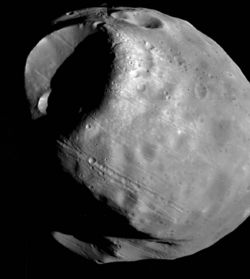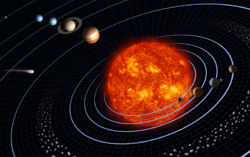Phobos
 From Conservapedia
From Conservapedia | Phobos | |
|---|---|
 Phobos by Viking Orbiter | |
| Date of discovery | August 18, 1877 |
| Name of discoverer | Asaph Hall |
| Name origin | Greek phobos fear; attendant of Greek god of war |
| Orbital characteristics | |
| Primary | Mars |
| Order from primary | 1 |
| Periareion | 9236.39 km[1] |
| Apareion | 9519.61 km[1] |
| Semi-major axis | 9,378 km[2] |
| Orbital eccentricity | 0.0151[2] |
| Sidereal month | 0.3189 da[2] |
| Synodic month | 0.3191 da |
| Avg. orbital speed | 2.138 km/s |
| Inclination | 1.093° to Mars's equator |
| Rotational characteristics | |
| Sidereal day | 0.3189 da |
| Rotational speed | 11.0 km/h |
| Axial tilt | 0° |
| Physical characteristics | |
| Mass | 1.073 * 1016 kg (1.795 * 10-7% earth)[1] |
| Density | 1,872 kg/m³[3] |
| Mean radius | 11.1 km[3] |
| Surface gravity | 5.81 * 10-3 m/s² (5.92 * 10-4 g)[1] |
| Escape speed | 0.0114 km/s[1] |
| Surface area | 2997 km²[1] |
| Minimum temperature | 161 K[4] |
| Mean temperature | 233 K |
| Maximum temperature | 269 K[4] |
| Composition | Rock and ice mix |
| Albedo | 0.071[3] |
Phobos (from the Greek φόβος or phobos fear) is the inner, and the larger, of the two satellites of Mars.
Contents
- 1 Discovery
- 2 Orbital and physical characteristics
- 3 Origin
- 4 Exploration
- 5 Gallery
- 6 References
Discovery[edit]
Phobos was discovered by the astronomer Asaph Hall on August 18, 1877, at the United States Naval Observatory in Washington, DC.[5][6][7] Astronomers were especially excited by the very short sidereal month of Phobos—about one-third of a Martian sidereal day—a phenomenon without precedent at the time.
The astronomer V. Knorre named the satellite Phobos (and also provided the name Deimos for the other satellite that Hall had discovered six days earlier), per a suggestion by Henry G. Madan of Eton, based on the names given in The Iliad for the two servants of Ares, the Greek god of war, named Fear (Phobos) and Panic (Deimos).[8]
Orbital and physical characteristics[edit]
Phobos orbits Mars at a distance closer than the distance of a synchronous orbit. For that reason, Phobos actually rises in the west and sets in the east of the Martian sky.[9] Yet because Phobos orbits Mars so closely, it is not visible above the horizon at latitudes higher than 70° north or south.
Phobos is not round, but is shaped like a potato, with dimensions 27 x 21.6 x 18.8 km. Its most remarkable surface feature is Crater Stickney, named for the family of Mrs. Asaph Hall. Stickney has a diameter of 10 km, and its outer rim has pronounced surface striations suggesting a tremendous impact.[9][10]
Phobos is spiraling in toward Mars at a rate of 18 mm per year. At that rate, if it had 50 million years to wait, it would enter the Martian atmosphere and drop to the surface in a cataclysmic crash, or else disintegrate into a ring.[4]
Origin[edit]
The favored theory among conventional astronomers is that Phobos and its companion moon Deimos are captured C-type asteroids.[4][9] However, that theory is not universally accepted.[4]
The Soviet spacecraft Phobos 2 discovered that Phobos was venting something into space, but all its systems failed before its controllers could determine what that substance was—most commentators believe that it was water.
In the 1950s and 1960s, a number of American and Soviet astrophysicists actually speculated that Phobos was hollow, and even that it was an artificial construct.[11] This speculation had part of its basis on a lack of understanding of Phobos' density and a gross overestimation of the rate of Phobos' orbital decay—5 cm per year instead of the 1.8 cm per year that present observations have established.
Exploration[edit]
The NASA probe Viking 1 took the first close-up photographs of Phobos on its way to deliver a landing craft to the Martian surface. Since then, several missions have made flybys of Phobos, including the orbiter that services the Spirit and Opportunity rovers, and the European Space Agency's Mars Express.[12][13]
Gallery[edit]

Successive views of Phobos photographed from the surface of Mars by the Spirit Mars rover

High-resolution of Phobos from the camera in the Mars Orbiter now in orbit around Mars
References[edit]
- ↑ 1.0 1.1 1.2 1.3 1.4 1.5 Calculated
- ↑ 2.0 2.1 2.2 "Planetary Satellite Mean Orbital Parameters," Solar System Dynamics, JPL, NASA. Accessed February 11, 2008.
- ↑ 3.0 3.1 3.2 "Planetary Satellite Physical Parameters." Solar System Dynamics, JPL, NASA. Accessed February 11, 2008.
- ↑ 4.0 4.1 4.2 4.3 4.4 "Entry for Phobos." Solar System Exploration, NASA. Accessed February 11, 2008.
- ↑ Authors unknown. "Notes: The Satellites of Mars." The Observatory, 1:181-185, 1877. Accessed February 11, 2008, from the SAO/NASA Astrophysics Data System, Harvard University.
- ↑ Hall, A. "Observations of the Satellites of Mars." Astronomische Nachrichten, 91(2161):11-14, 1877. Accessed February 11, 2008.
- ↑ Morley, TA. A catalogue of ground-based astrometric observations of the Martian satellites, 1877-1982, Astronomy and Astrophysics Supplement Series (ISSN 0365-0138), 77(2):209-226, February 1989. Accessed February 11, 2008.
- ↑ Knorre, V. "Entdeckung zweier Planeten." Astronomische Nachrichten, 92(2187):47-48, March 14, 1878. Accessed February 11, 2008.
- ↑ 9.0 9.1 9.2 "Entry for Phobos." The Planetary Society. Accessed February 11, 2008.
- ↑ "Entry for Phobos." Mars Exploration Program, NASA. Accessed February 11, 2008.
- ↑ Öpik, E. J. "Is Phobos Artificial?" Irish Astronomical Journal, 6:281, September 1964. Accessed February 11, 2008.
- ↑ "Close Inspection for Phobos." Mars Express, European Space Agency, February 11, 2008.
- ↑ "Martian Moon Phobos in Detail." Mars Express, European Space Agency, November 11, 2004. Accessed February 11, 2008.
| |||||||||||||||||||||||||||||
↧ Download as ZWI file | Last modified: 02/19/2023 19:55:03 | 52 views
☰ Source: https://www.conservapedia.com/Phobos | License: CC BY-SA 3.0
 ZWI signed:
ZWI signed:
 KSF
KSF